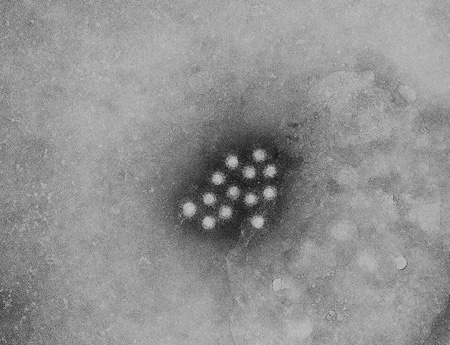Etiology
Hepatitis A virus (HAV) is a 27-nm, nonenveloped, icosahedral RNA virus.[16][17][Figure caption and citation for the preceding image starts]: An electron micrograph of the hepatitis A virusCDC/Betty Partin; used with permission [Citation ends]. The virus is resistant to bile lysis due to lack of a lipid envelope.[18] The virus is resistant to freezing, detergents, and acids. It is inactivated by formalin and chlorine. The virus survives on human hands and fomites and requires temperatures higher than 185°F (85°C) for inactivation.[19][20] HAV survives for extended periods in seawater, fresh water, wastewater, and soil.[19] The virus is transmitted by close contact with an infected person or by contact with contaminated food or water products.
The virus is resistant to bile lysis due to lack of a lipid envelope.[18] The virus is resistant to freezing, detergents, and acids. It is inactivated by formalin and chlorine. The virus survives on human hands and fomites and requires temperatures higher than 185°F (85°C) for inactivation.[19][20] HAV survives for extended periods in seawater, fresh water, wastewater, and soil.[19] The virus is transmitted by close contact with an infected person or by contact with contaminated food or water products.
Children are a key source of HAV infection in developing countries. Infection is frequently unrecognized in children, who can continue to shed virus in their feces for months after infection. In countries where children are routinely vaccinated against hepatitis A, transmission primarily occurs between adults.[21] Foods associated with outbreaks are typically eaten raw, and include fruits, vegetables, and shellfish.[21] The disease may also be acquired by direct contact with contaminated water or ice (including shellfish harvested from sewage-contaminated water), from contaminated frozen foods, or from foods contaminated by infected food handlers.[22][23]
Pathophysiology
After oral inoculation the virus is transported across the intestinal epithelium by a poorly understood transport mechanism. After traveling through the mesenteric veins to the liver, the virus enters hepatocytes, where replication of hepatitis A virus (HAV) occurs exclusively within the cytoplasm via RNA-dependent polymerase. Virus particles are secreted into bile and blood from the infected hepatocytes. Viral particles are excreted in stool or reabsorbed into the enterohepatic circulation.[19]
Liver injury occurs when cytotoxic T cells lyse the infected hepatocytes. Natural killer cells may also contribute to cell lysis.[19][24][25]
An excessive host response (observable clinically by a marked degree of reduction of HAV RNA during acute infection phase) is associated with severe hepatitis.[26]
Use of this content is subject to our disclaimer